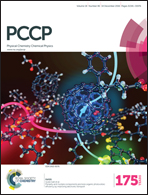Structure and stability of neutral Al–Mg nanoclusters up to 55 atoms†
Abstract
The geometries of aluminum–magnesium nanoalloys are explored using a genetic algorithm applied to the Gupta potential function and tuned to search for the 10 lowest energy minima for each cluster size and composition. Each structure is re-optimized using density functional theory calculations, allowing both a classical and quantum analysis of the system. Average binding energies, excess energies and HOMO–LUMO gaps are calculated. Differences between classical and quantum descriptions are discussed. The results reveal structures that are particularly stable, and a discussion on magic numbers of valence electrons is presented.


 Please wait while we load your content...
Please wait while we load your content...